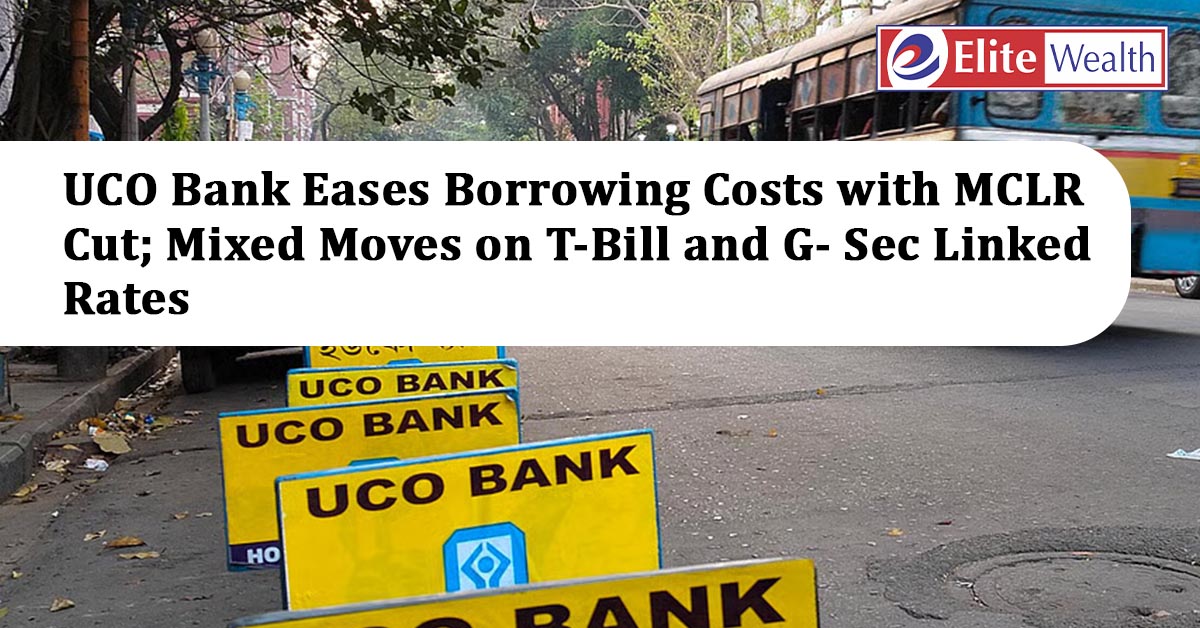
UCO Bank, a leading public sector lender, has revised its benchmark interest rates effective September 10, 2025, reflecting a calibrated response to prevailing monetary conditions. While the bank has lowered its Marginal Cost of Funds Based Lending Rate (MCLR) across all tenors by 5–10 basis points (bps), other benchmark-linked rates, including Treasury Bill (TBLR) and G-Sec rates, saw selective upward adjustments.
MCLR: Lending Becomes Slightly Cheaper
The most significant change is the downward revision in MCLR, which directly impacts borrowers with MCLR-linked loans.
| Tenor | Previous Rate | New Rate | Change |
| Overnight | 8.15% | 8.05% | -10 bps |
| One month | 8.35% | 8.30% | -5 bps |
| Three month | 8.50% | 8.45% | -5 bps |
| Six month | 8.75% | 8.70% | -5 bps |
| One year | 8.95% | 8.90% | -5 bps |
The cut is expected to marginally lower borrowing costs for retail, MSME, and corporate customers, particularly those with one-year MCLR-linked loans, which remain the industry benchmark.
Treasury Bill Linked Rate (TBLR): Mixed Adjustments
The 3-month TBLR has increased by 10 bps (from 5.35% to 5.45%), reflecting recent movement in short-term money market yields. Meanwhile, the 6-month (5.50%) and 12-month (5.55%) TBLRs remain unchanged.
G-Sec Linked Rates: Upward Revisions
G-Sec benchmarks have also been adjusted in line with government bond yields:
- UCO G-Sec Rate (1 year): 5.64% → 5.67%
- 10-year G-Sec YTM (Annualized Par yield): 6.51% → 6.78%
This suggests higher long-term borrowing costs could persist, even as short-term retail lending sees some relief.
Unchanged Benchmark Rates
Several key lending benchmarks remain steady, providing stability across customer segments:
- Repo Linked Rate – UCO Float: 8.30%
- Repo Linked Rate – UCO Prime: 5.50%
- Base Rate: 9.60%
- Benchmark Prime Lending Rate (BPLR): 14.25%
Expert View: Balancing Growth and Market Dynamics
The rate adjustments reflect UCO Bank’s nuanced approach to aligning lending rates with liquidity trends and funding costs. The MCLR cut is growth-friendly, aimed at stimulating credit demand, particularly in a softening inflation environment. However, the upward revision in certain T-Bill and G-Sec rates underscores lingering volatility in debt markets and the cautious stance on longer-term rate risks.
Implications for Borrowers and Investors
- Borrowers: Home, auto, and MSME borrowers with MCLR-linked loans may see marginal reductions in EMIs.
- Investors: Higher G-Sec linked benchmarks could translate into costlier long-term borrowings, influencing corporate bond issuances and infrastructure financing.
- Depositors: With repo-linked rates unchanged, deposit rates are unlikely to see significant shifts in the near term.
Conclusion
UCO Bank’s latest rate realignment highlights the delicate balance between supporting credit growth and adapting to shifting yield dynamics. For borrowers, the reduction in MCLR provides incremental relief, while investors should watch for sustained movement in G-Sec yields that may dictate the trajectory of lending rates in the coming quarters.
Disclaimer:
This article is intended solely for educational and informational purposes. The securities or companies mentioned are provided as examples and should not be considered as recommendations. Nothing contained herein constitutes personal financial advice or investment recommendations. Readers are advised to conduct their own research and consult a qualified financial advisor before making any investment decisions.
Investments in securities markets are subject to market risks. Please read all related documents carefully before investing.
